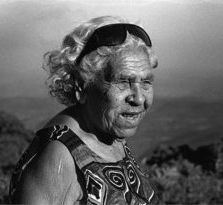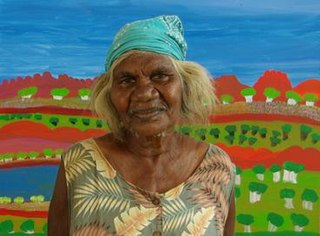Related Research Articles

Queenie McKenzie (Nakarra) (formerly Oakes, or Mingmarriya) (c. 1915 – 16 November 1998) was an Aboriginal Australian artist. She was born on Old Texas Station, on the western bank of the Ord River in the East Kimberley.

Emily Kame Kngwarreye was an Aboriginal Australian artist from the Utopia community in the Northern Territory. After only starting painting as a septuagenarian, Kngwarreye became one of the most prominent and successful artists in the history of Indigenous Australian art.
Minnie Pwerle was an Australian Aboriginal artist. She came from Utopia, Northern Territory, a cattle station in the Sandover area of Central Australia 300 kilometres (190 mi) northeast of Alice Springs.
Pansy Napangardi is an Australian artist. She is associated with the Jukurrpa group of women artists in Alice Springs where she lives today.
Kathleen Petyarre was an Australian Aboriginal artist. Her art refers directly to her country and her Dreamings. Petyarre's paintings have occasionally been compared to the works of American Abstract Expressionists Jackson Pollock and Mark Rothko, and even to those of J. M. W. Turner. She has won several awards and is considered one of the "most collectable artists in Australia". Her works are in great demand at auctions. Petyarre died on 24 November 2018, in Alice Springs, Australia.
Susie Bootja Bootja Napaltjarri was an Indigenous artist from Australia's Western Desert region. Born south-west of Balgo, Western Australia, in the 1950s Susie Bootja Bootja married artist Mick Gill Tjakamarra, with whom she had a son, Matthew Gill Tjupurrula.
Tjunkiya Napaltjarri was a Pintupi-speaking Indigenous artist from Australia's Western Desert region. She is the sister of artist Wintjiya Napaltjarri.
Wintjiya Napaltjarri, and also known as Wintjia Napaltjarri No. 1, is a Pintupi-speaking Indigenous artist from Australia's Western Desert region. She is the sister of artist Tjunkiya Napaltjarri; both were wives of Toba Tjakamarra, with whom Wintjiya had five children.
Contemporary Indigenous Australian art is the modern art work produced by Indigenous Australians, that is, Aboriginal Australians and Torres Strait Islander people. It is generally regarded as beginning in 1971 with a painting movement that started at Papunya, northwest of Alice Springs, Northern Territory, involving Aboriginal artists such as Clifford Possum Tjapaltjarri and Kaapa Tjampitjinpa, and facilitated by white Australian teacher and art worker Geoffrey Bardon. The movement spawned widespread interest across rural and remote Aboriginal Australia in creating art, while contemporary Indigenous art of a different nature also emerged in urban centres; together they have become central to Australian art. Indigenous art centres have fostered the emergence of the contemporary art movement, and as of 2010 were estimated to represent over 5000 artists, mostly in Australia's north and west.
Josepha Petrick Kemarre is an Anmatyerre-speaking Indigenous Australian artist from Central Australia. Since first taking up painting around 1990, her works of contemporary Indigenous Australian art have been acquired by several major collections including Artbank and the National Gallery of Victoria. Her paintings portray bush plum "dreaming" and women’s ceremonies. One of her paintings sold at a charity auction for A$22,800. Josepha Petrick's works are strongly coloured and formalist in composition and regularly appear at commercial art auctions in Australia. Her art appears to have survived the huge contraction of the primary art market in Australia since 2008. There is no existing Catalogue raisonné of Josepha Petrick's artworks, to date, no fakes have been cited.
Kathleen Ngale is a senior Australian Aboriginal artist, born c. 1930 in the Utopia region of Central Australia. Kathleen Ngale belongs to the oldest living generation of Utopia artists and has been compared to Emily Kngwarreye, Minnie Pwerle, and Kathleen Petyarre.
Tjayanka Woods is an Australian Aboriginal artist. She was one of the pioneers of the art movement across the Ngaanyatjarra, Pitjantjatjara and Yankunytjatjara lands, which began in 2000. She is best known for her paintings, but also a craftswoman who makes baskets and other woven artworks. Her paintings are held in the Art Gallery of Western Australia, National Gallery of Victoria, and the National Gallery of Australia.
Tjungkara Ken is a Pitjantjatjara artist from Amata, South Australia, in the APY lands. She began painting in 1997, when Minymaku Arts was opened by the women of Amaṯa. She started painting professionally in 2008. By that time, the artists' co-operative had been renamed Tjala Arts.
Maringka Baker is an Aboriginal artist from central Australia. She lives in the Pitjantjatjara community of Kaṉpi, South Australia, and paints for Tjungu Palya, based in nearby Nyapaṟi.Maringka is known for her paintings. Maringka paints sacred stories from her family's Dreaming (spirituality). As well as the important cultural meanings they carry, her paintings are known for being rich in colour and contrast. She often paints the desert landscape in bright green colours, and contrasts it against reds and ochres to depict landforms. She also uses layers of contrasting colours to show the detail of the desert in full bloom.
Tali Tali Pompey was an Aboriginal artist from central Australia. She had a short career as an artist, beginning only in 2002. During this time, however, her work was taken in by several major public galleries.
Julie Gough is an artist, writer and curator based in Tasmania, Australia.

Munmarria Daisy Andrews, known professionally as Daisy Andrews, was an Australian artist originally from the Walmajarri desert tribe. After taking up artwork later in life – initially illustrating the personal stories of fellow community members – Andrews began exhibiting her paintings in group and solo showings across Australia. She was known for her vividly red landscapes showcasing the mountain ranges of the Great Sandy Desert. In 1994, she received the main Telstra award from the National Aboriginal and Torres Strait Islander Art Awards (NATSIAA) for her painting Lumpa Lumpa landscape.
Narputta Nangala Jugadai (1933–2010) was an Aboriginal Australian artist born at Karrkurutinytja, who later lived at Haasts Bluff (Ikuntji) in the Northern Territory. Her language group was Pintupi/Pitjantjatjara, and her Dreaming was "Snake", "Jangala, Two Men" and "Two Women". She was a senior artist in her community at Ikuntji and prominent among the Ikuntji Women's Centre painters. She was the wife of the painter, Timmy Tjungurrayi Jugadai, and mother of Daisy Jugadai Napaltjarri and Molly Jugadai Napaltjarri.
Long Jack Phillipus Tjakamarra, occasionally referred to as Kumantjayi Long Tjakamarra, was a Ngalia/Warlpiri man and a founding member of the Papunya Tula art cooperative. His contribution to the Honey Ant Dreaming mural would help define and catalyze the art style of the Western Desert Art Movement.
Angelina Pwerle is an Australian Indigenous artist, born c. 1946 in the Utopia region of Central Australia. Her work is held by the Metropolitan Museum of Art, the National Gallery of Australia and others.
References
- 1 2 3 Dayman, Karen (June 2005). "Paji Honeychild Yankarr (obituary)". Artlink. Retrieved 2 August 2018.
- 1 2 "Kurntumarrajarra: The Estate of Paji Wajina Honeychild Yankarr" (PDF). ReDot Gallery Newsletter. June 2013. Retrieved 2 August 2018.
- ↑ "Paji Honeychild Yankarr". Collection Online. National Gallery of Victoria. Retrieved 2 August 2018.
- ↑ ReDot Fine Art Gallery (26 June 2014). "Kurntumarrajarra - The Estate of Paji Wajina Honeychild Yankarr". Issuu. Retrieved 2 August 2018.Includes online illustrated catalogue of exhibition